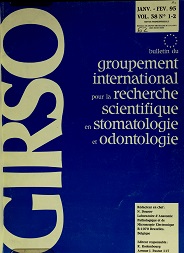Anatomical considerations relevant to implant procedures in the mandible
Keywords:
mandible, oral implantologyAbstract
The authors review anatomical facts significant for preoperative planning of implant procedures in the mandible. This planning includes the precise evaluation of distinct anatomical factors, such as the position of the mandibular canal, the width of the mandibular cortical plates and the degree of involutive changes of the inferior dental artery.
The mandibular canal is usually situated centrally in the mandibular corpus, slightly closer to the lingual cortex in its distal parts; towards the front, it approaches the vestibular cortical layer. Mesially from the mental foramen, a clearly defined incisive canal is present in only one third of the edentate mandibles.
Mandibular corpus of the edentate mandibles consists of cancellous bone enclosed by a shell of compact cortical bone. Cortical layers demonstrate significant variations in width; nervertheless, the widths of lateral cortical layers, generally, enable safe placement of endosseal implants.
Finally, in patient’s preoperative assessment, involutive changes of the inferior dental artery should also be considered. During the involution of the mandibular alveolar process, it shows changes of direction and calibre, changes in arborization and, sometimes, complete occlusion of the main trunk. The degree of these involutive changes points out the mandibular vascular supply and the regenerative capacity of the tissues needed for the success of the implant procedure.
Downloads
Published
Issue
Section
License
I hereby certify that the authors of the above manuscript have all:
1. Conceived, planned, and performed the work leading to the report, or interpreted the evidence presented, or both;
2. Written the report or reviewed successive versions and shared in their revisions; and
3. Approved the final version.
Further, I certify that:
1. This work has not been published elsewhere and is not under revision in another journal;
2. Humane procedures have been followed in the treatment of experimental animals (if applicable);
3. Investigations in humans was done in accordance with the ethical standards of the responsible committee on human experimentation or with the Helsinki Declaration (if applicable).
4. This paper has been carefully read by a native English speaker who is familiar with the field of work (this applies to authors who are not fluent in English); and
5. The copyright of the article is transferred from the authors to the Bulletin du Groupement International pour la Recherche Scientifique en Stomatologie et Odontologie upon acceptance of the manuscript.



